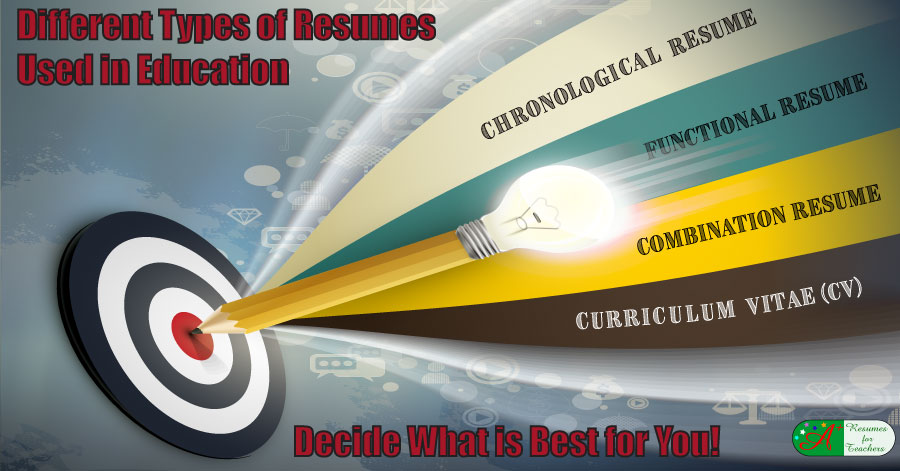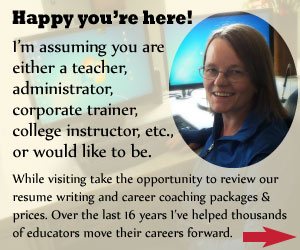Different Types of Resumes Used in Education - Decide What is Best for You!
It might seem like all resumes are the same, but after you have read a few, you will discover there are actually some substantial differences. The format you choose can be the deciding factor between getting called for a job interview or sending out more copies of your resume.
There are many aspects that separate an attention-grabbing resume from an unsuccessful resume. Many job seekers make the mistake of thinking that the layout of the resume is unimportant. The reality is that the layout of your resume is almost as important as the information you include. Your resume must be visually appealing and represent your information in the best light possible.
There are three popular types of layouts you can choose to use. I would estimate that at least 90% of the resumes created are either set up using a chronological resume format or a functional resume format. The third is the combination resume format that is used in some cases, but is growing in popularity.

The Chronological Resume
When you write a chronological resume, you will want to make sure your employment and educational accomplishments are listed in chronological order. The key is to put your most recent experiences at the top and work your way down. The reason most prospective employers prefer a chronological resume to a functional resume is because it makes it easier for them to access your background and qualifications. It lets them see how quickly you have progressed, and how long you stick to employment commitments, versus whether you got laid off frequently or fired. It also shows immediately if you have any gaps in your work history.
The chronological resume is a benefit to many job seekers because it can highlight impressive organizations where they worked, demonstrate a solid work history, and show progression — all an added benefit. Furthermore, it translates easily when filling out a job application in person or online, as these documents are chronological in nature. The downfall to some job seekers is if their job history is not perfect it will show every gap or time periods where they didn't progress within their career.
The Functional Resume
The second type of resume that you should know about is called a functional resume. Instead of listing your employment and educational history in order, you will want to turn the focus on your skill sets. When you create a functional resume, the aim is to draw attention to the highlights you have experienced that are relevant to the position you are seeking. It includes skills-based, categorical sections, which helps to determine if you are qualified for the position.
Functional resumes are commonly used when a student is seeking an internship, a stay at home mom or dad entering the workforce, or by someone who is interested in making a career change.
The Combination Resume
The third type of resume that you might want to consider is a style that incorporates both the chronological and functional resume format. This type of resume is appropriately called a combination resume, and it is becoming increasingly popular. The reason professionals are starting to use a combination style is because it gives them the freedom to draw a prospective employer's attention to their skills, while also showing they have a strong educational and employment history.
Once you have decided on the type of resume you want to produce, ensure that all the information is clear and concise. Additionally, do not overload your resume with information, otherwise it will ruin your chances of getting an interview — remember to save some details for the interview.
Curriculum Vitae (CV) vs. Resume
You have probably heard of a CV before. Although it may seem "fancier" or "better," it is really just a different method to lay out your career information. In the world of education, as with many professions, resumes are preferable to CVs. A CV is generally used by professionals in medicine, law, and other specialized positions. This document allows a person to list education, career experience, professional development, and so forth. However, it does not give room for expansion and the incorporation of key information such as job responsibilities and specific career accomplishments. A resume allows you to provide more detail and concrete examples as to why you are the best candidate for the job.
Regardless of the Type of Resume You Choose
Whether you use a chronological, functional, or combination resume, your document must include the basics:
- Profile
- Areas of Expertise / Core Competencies
- Formal Education and Credentials
- Teaching Experience
- Job Accomplishments
- Professional Development
- Professional Affiliations
- Publications and Presentations (if any)
- Community Involvement
Your resume should be no more than two pages, and only include relevant information. If you find you are barely over one, either dig deeper for more examples or statistics you can include, or change the formatting to keep it an even one page. Make certain your professional references are not listed on your resume, they should instead appear on a separate page.
When creating a matching cover letter, make sure to keep a similar format in mind. If your resume is functional, focus more on the hard skill sets you bring to the classroom. If your resume take a chronological approach, highlight the years of experience you have had, the types of students you have worked with, and courses taught — don't forget to include skills and strengths as well though!
Don't let choosing the wrong type resume cost you job interviews. If you require more information or have any questions - Contact Candace at A+ Resumes for Teachers by clicking here or call toll-free 1-877-738-8052.

